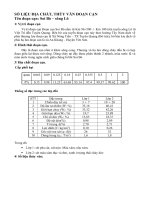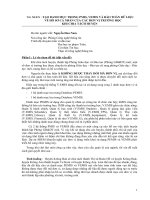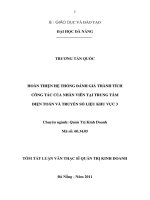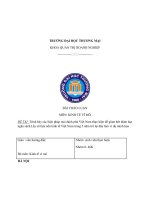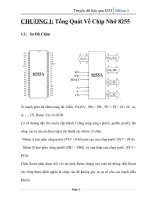Ch3 3 v1 TRUYỀN SỐ LIỆU VÀ MẠNG
Bạn đang xem bản rút gọn của tài liệu. Xem và tải ngay bản đầy đủ của tài liệu tại đây (284.64 KB, 23 trang )
Chapter 3
Data and Signals
3.1
Copyright © The McGraw-Hill Companies, Inc. Permission required for reproduction or display.
3-4 TRANSMISSION IMPAIRMENT
Signals travel through transmission media, which are not
perfect. The imperfection causes signal impairment. This
means that the signal at the beginning of the medium is
not the same as the signal at the end of the medium.
What is sent is not what is received. Three causes of
impairment are attenuation, distortion, and noise.
Topics discussed in this section:
Attenuation
Distortion
Noise
3.2
Figure 3.25 Causes of impairment
3.3
3.4
Attenuation
3.5
Means loss of energy -> weaker
signal
When a signal travels through a
medium it loses energy overcoming
the resistance of the medium
Amplifiers are used to compensate
for this loss of energy by
amplifying the signal.
Measurement of
Attenuation
To show the loss or gain of
energy the unit “decibel” is
used.
dB = 10log10P2/P1
P1 - input signal
P2 - output signal
3.6
Figure 3.26 Attenuation
3.7
Example 3.26
Suppose a signal travels through a transmission medium
and its power is reduced to one-half. This means that P2
is (1/2)P1. In this case, the attenuation (loss of power)
can be calculated as
A loss of 3 dB (–3 dB) is equivalent to losing one-half
the power.
3.8
Example 3.27
A signal travels through an amplifier, and its power is
increased 10 times. This means that P2 = 10P1 . In this
case, the amplification (gain of power) can be calculated
as
3.9
Example 3.28
One reason that engineers use the decibel to measure the
changes in the strength of a signal is that decibel
numbers can be added (or subtracted) when we are
measuring several points (cascading) instead of just two.
In Figure 3.27 a signal travels from point 1 to point 4. In
this case, the decibel value can be calculated as
3.10
Figure 3.27 Decibels for Example 3.28
3.11
Example 3.29
Sometimes the decibel is used to measure signal power
in milliwatts. In this case, it is referred to as dBm and is
calculated as dBm = 10 log10 Pm , where Pm is the power
in milliwatts. Calculate the power of a signal with dBm =
−30.
Solution
We can calculate the power in the signal as
3.12
Example 3.30
The loss in a cable is usually defined in decibels per
kilometer (dB/km). If the signal at the beginning of a
cable with −0.3 dB/km has a power of 2 mW, what is the
power of the signal at 5 km?
Solution
The loss in the cable in decibels is 5 × (−0.3) = −1.5 dB.
We can calculate the power as
3.13
3.14
Distortion
3.15
Means that the signal changes its form
or shape
Distortion occurs in composite signals
Each frequency component has its own
propagation speed traveling through a
medium.
The different components therefore
arrive with different delays at the
receiver.
That means that the signals have
different phases at the receiver than
they did at the source.
Figure 3.28
3.16
Distortion
3.17
Noise
There are different types of
noise
3.18
Thermal - random noise of electrons
in the wire creates an extra signal
Induced - from motors and appliances,
devices act are transmitter antenna
and medium as receiving antenna.
Crosstalk - same as above but between
two wires.
Impulse - Spikes that result from
power lines, lighning, etc.
Figure 3.29
3.19
Noise
Signal to Noise Ratio
(SNR)
3.20
To measure the quality of a system
the SNR is often used. It
indicates the strength of the
signal wrt the noise power in the
system.
It is the ratio between two
powers.
It is usually given in dB and
referred to as SNRdB.
